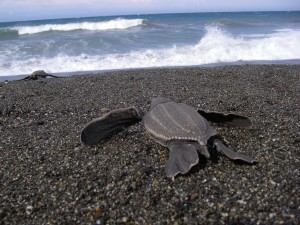
Leatherback sea turtles (Dermochelys coriacea), the world’s largest species of turtle, will now benefit from increased levels of protection along the U.S. Pacific Coast, including the marine habitats of NOAA’s West Coast Sanctuaries. On January 20, the National Marine Fisheries Services (NMFS) protected approximately 41,914 square miles (108,558 square km) of Pacific Coast waters as critical habitat for the endangered leatherback sea turtle. Approximately 16,910 square miles (43,798 square km) of this area stretches along the California coast from Point Arena to Point Arguello east of the 3000 m depth contour, while the remainder extends from Cape Blanco in Oregon to the Canadian border. Within these areas, the critical habitat designation extends from the ocean surface down to a maximum depth of 262 feet (80 m).
Leatherbacks feed on soft-bodied animals such as jellies and salps and can attain weights of up to 2000 pounds and lengths of 6.5 feet! They are most abundant in West Coast Sanctuaries during the summer and fall months, when large aggregations of jellies form. Tolerant of a wide range of water temperatures, leatherback sea turtles are more abundant in the Atlantic Ocean than in the Pacific, but are distributed throughout all the world’s oceans. Although leatherback sea turtles have been observed at latitudes as high as 71° north and 47° south latitude, nesting is confined to tropical and subtropical latitudes. As the only sea turtle species lacking a bony shell, leatherbacks have a streamlined carapace and long, paddle-shaped flippers. These adaptations allow them to embark on long-distance migrations, with some individuals traveling distances of up to 6000 miles from nesting sites in Indonesia to feed on sea nettles and other types of jellies in Monterey Bay.
Leatherback sea turtles are particularly vulnerable due to a multiple threats in both marine and terrestrial environments. Threats include incidental capture or entanglement in fishing gear, ingestion of marine debris, environmental contamination, vessel strikes, disease, climate change, harvesting of both eggs and nesting females, and loss or degradation of nesting habitat due to beach armoring, artificial lighting, and the spread of non-native vegetation. The International Union for the Conservation of Nature (IUCN) estimates that most leatherback nesting populations have declined more than 80% from historic levels. For just the Pacific population, estimates indicate decreases of almost 95% since the 1980s.
Leatherback sea turtles were first added to the federal Endangered Species List in 1970. Until now, the only federal critical habitat designation for leatherbacks has been adjacent to the U.S. Virgin Islands, home to one of the more significant nesting colonies within the U.S. Exclusive Economic Zone. The new critical habitat designation off the Pacific Coast by NMFS comprises the largest sea turtle protected habitat in the U.S., and reflects an important decision to protect sea turtle feeding areas in addition to nesting areas. Critical habitat designation means that a review of impacts to leatherbacks must be included in all new federal permits, covering everything from desalination facilities to proposals for offshore drilling.
To learn more about the natural history of leatherback sea turtles, check out information at NOAA’s Office of Protected Resources.
Learn more about leatherback sea turtle conservation efforts in MBNMS by watching this video: http://www.youtube.com/watch?v=Q_yXHGQYpBc